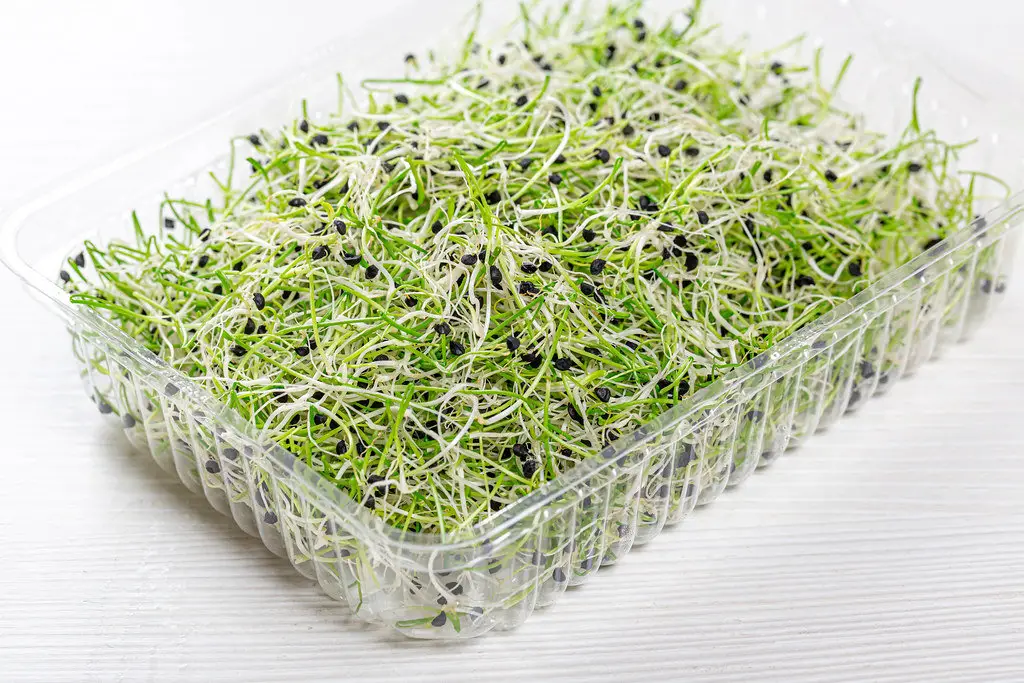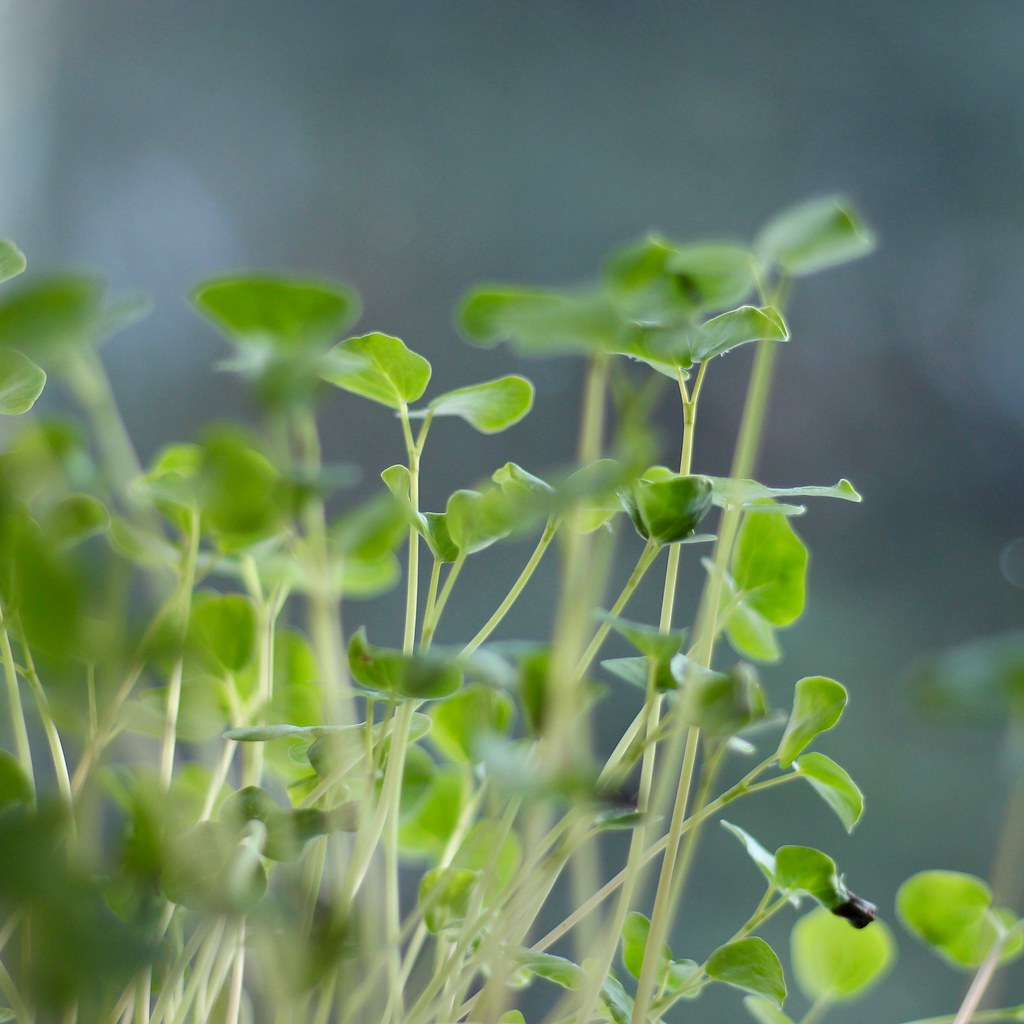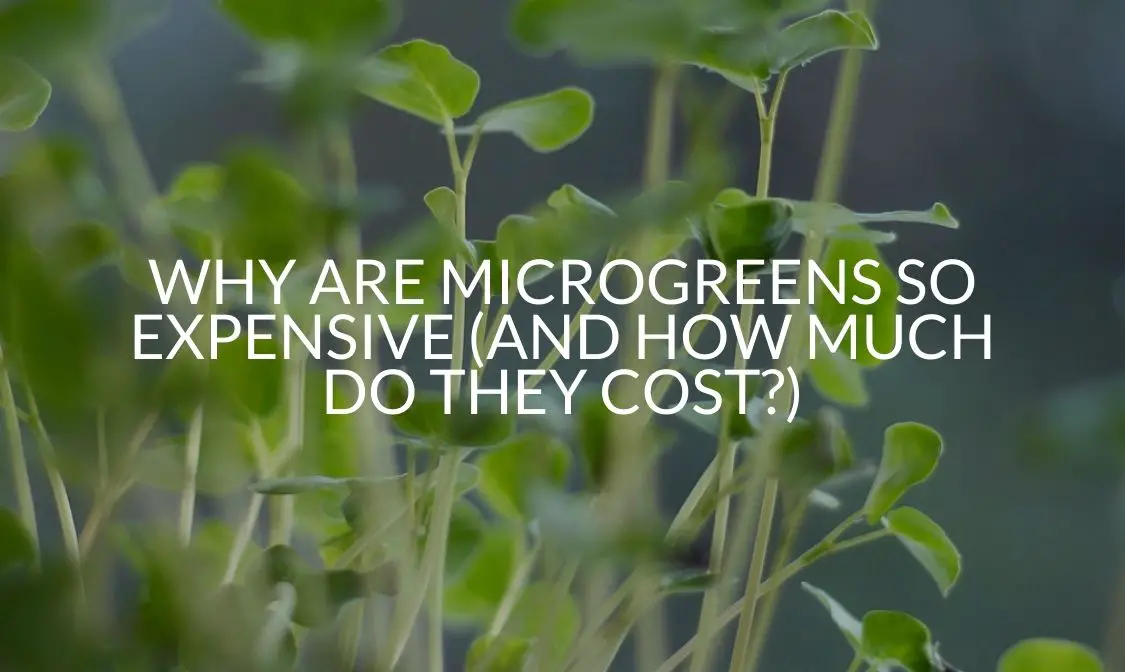If you pay attention to the trends in diets, you might think about trying microgreens, however, then you go to the store and see how expensive they are. At which point, you’ll probably ask yourself “why are microgreens so expensive?”
The reason they are so costly has to do with a few things. Including the way they are grown, the square footage needed for yield, and the equipment you must use to produce them.
As we talk more about why microgreens are so expensive, we’ll have to dive into what microgreens are, how they are grown, the seeds, the price range, and the benefits of microgreens.
What Are Microgreens?
Microgreens are the first leaves that appear after the germination of the plant. To put it simply, these are the baby leaves. That is why these plants are so small.
Being that they are the first leaves after germination they are a lot higher in nutrients. Nutrients that provide health benefits to your body; those health benefits are what make them so trendy to the health conscience (And one of the reasons they’re so expensive).
Related Articles:
- DIY Microgreen Rack Setup: Everything You Need To Know To Grow Microgreens At Home
- How To Grow Microgreens On A Paper Towel
- Microgreens Humidity And Temperature (Complete Guide)
How Are Microgreens Grown?
Growing microgreens is a rather involved project. There are certain things that you’ll need to grow microgreens that are going to add to the cost. Things like the growing medium or mats cannot be used twice. Whereas other things, like trays, can be washed and reused.
Here are some items that you would need to grow microgreens:
- Seeds
- Clean water
- Dirt or growing mat
- Pots or trays
- A scale or measuring cups
- Spray bottle and a jug
Seeds
Of course, you will need the seeds. Without seeds, you cannot grow any plant. You also have to determine the number of seeds you will need for any growing medium or tray. Once you have correctly calculated the number of seeds, you use a scale or measuring spoon or cup to do future measures.
Trays
Growers can use trays or containers of various sizes and shapes.
Generally, level trays like flats of flowers are the best for growing microgreens. When selecting a tray, you need to make sure that it has drainage.
Growing Medium Or Mats
The trays must be set with the growing agent. This part is necessary; you need to place the trays in a larger tray to soak up water from the bottom of the tray to make the dirt or grow mat wet. The medium being wet allows the tiny seeds to attach to the dirt top and keeps the roots moist while they germinate.
The dirt or mats cannot be used twice. If the medium is organic, it can be composted, but otherwise, it will have to be thrown away
Seeding Trays
Now that the medium is in the trays and wet, you can seed the trays. The number of seeds for the tray should be distributed evenly over the tray. The seeds do not need to have dirt placed over them. However, you will need to spray them with water from a mist bottle from time to time in order to keep them damp during the sprouting period.
For several days in the sprouting process, it is suggested that seeds not have direct light on them. You can place them in a dark room with no windows or use another tray without drain holes as a cover.
For certain varieties of seeds, such as sunflower, it is advised that you have something heavy to put on the roots during germination. The weight keeps the kernels in touch with the moist soil.
After the leaves become tall enough, it is time to expose them to sunlight .
Harvesting Microgreens
Depending on the species, microgreens can be ready to harvest in a couple of days to a couple of weeks after the germination process is complete. To harvest microgreens, you will need a sharp knife or sharp pair of scissors.

Type Of Microgreens
There are several types of microgreens, and they come from different plant families. The most fashionable are:
- Brassicaceae family: Cauliflower, broccoli, cabbage, watercress, radish, and arugula
- Asteraceae family: Lettuce, endive, chicory, and radicchio
- Apiaceae family: Dill, carrot, fennel, and celery
- Amaryllidaceae family: Garlic, onion, leek
- Amaranthaceae family: Amaranth, quinoa swiss chard, beet, and spinach
- Cucurbitaceae family: Melon, cucumber, and squash
See How Microgreens Are Grown
You can see how microgreens are grown in this video. This video will give you an idea of the amount of labor, time, and items needed to grow microgreens. We suggest if you are thinking of growing microgreens, you start here by watching that video.
What Else Adds To The Cost Of Microgreens?
Another reason microgreens are so expensive is the health benefits. These include a larger amount of vitamins and nutrients in microgreens compared to their adult varieties. For example, adult Arugula contains the following:
- 108mg Vitamin K
- 15mg Vitamin C
- 1.4mg Beta Carotene
- 3.6mg Lutein
- 0.4mg vitamin E
Now compare that to microgreen arugula
- 160mg Vitamin K
- 45.8mg Vitamin C
- 7.5mg Beta Carotene
- 5.4mg Lutein
- 19.1mg vitamin E.
As you can see, there’s quite a difference between the vitamins and minerals in both. It is also what makes them so appealing to people who take their health very seriously when it comes to the food they put in their bodies.
Why am I telling you this? Because that difference in the nutrients and the trend it sets make microgreens more expensive, but for some people, it is well worth the price to know that the food they are eating is healthier with more vitamins and nutrients.
Related Articles
- What Are The Best Tasting Microgreens (And What Do They Taste Like?)
- How To Grow Cilantro Microgreens (FAQ, Benefit, Pests)
- How To Grow Chickpea Microgreens (Benefits, FAQ, Pests)
Are Microgreen Seeds Expensive?
The quick and easy answer to “are microgreen seeds expensive?” is yes; they can be.
However, it does will depend on the variety you purchase, if they’re organic, and where you buy them.
Some varieties will be cheaper; these are usually mixed. Some will be quite expensive. The best thing you can do is to shop around. Don’t just look at a particular variety but also the amount in the package, if it is organic and where it actually comes from.
Another thing when it comes to the price and size of the package is how many seeds you need per tray. How many trays are you going to grow of the same variety? All these things need to be calculated into the price you are budgeting or willing to spend on seeds. Also, how many times in a year are you going to grow that particular variety of microgreens? Arugula, for example, you may want to grow year round.
Remember individual microgreen seeds cost more than regular plant seeds or even seedling plants; which is just one more reason that microgreens are expensive in the store.

What’s The Price Range Of Microgreens?
Let’s look at a few microgreens and the price range of those microgreens.
Here are how much some common microgreen seed packets cost:
- Color Mix Microgreens: A 1.5-ounce package will cost $5.00 and an 8-ounce package $21.00 from Perfect Food in NY., It’s a variety mix including Broccoli, Purple Radish, Arugula, Cilantro, ; Mustard.
- Sunflower Microgreens ranges from $5.99 for 1/4pound to $19.99 for a whole pound from Sunburst Greens in Kansas. They provide a nice crunch and a pleasant nutty flavor.
- Broccoli Microgreens range from 2 ounces for $5.00, or 8 ounces for $16.00 from Perfect Food NY. Broccoli is known for its anti-cancer nutrient, Sulforaphane.
- Pea Microgreens / Pea Shoots between 4 ounces and 1 pound cost $5.50 to $16.00 and provide a mild sweet pea flavor.
- Organic Micro Mix You must check for availability, but the price for 2.5 ounces is $4.99 and contains a mix of broccoli to zinger arugula and a few in between.
- Blue Moon Acres Organic Micro Greens Sampler costs $3.49 for one ounce and has a mix of varieties to try.
Now let’s look at some seed prices.
- Organic Basic Salad Mix Microgreens Seeds Organic by OTCO are a flavorful and colorful combination of microgreens and cost 3 grams $2.99 for 3 grams
- Spicy Micro Salad Mix Microgreens Seeds (1 lb) Contains: Broccoli, Kale, Kohlrabi, Arugula, Red Cabbage; Southern Giant Mustard for an extra kick price ranges from $22.00 to $30.00.
- Microgreens Burpee’s Mix 1 packet 400 seeds 5.95 contains 20% Beet Detroit Red, 20% Cabbage Pak Choi, 20% Kohlrabi Purple, 20% Broccoli Di Cicco and 20 % Radish China Rose.
- Radish, Daikon Organic Microgreen Seed add spicy flavor, visual appeal, and bulk to mixes 1 Ounce $3.75, a quarter-pound $6.20 1 Pound $10.80 5 pounds $49.00
- Pea – Speckled – microgreens seeds tasty organic pea shoots 25 Gram packets to 25 pounds price range is from $2.99 to $78.49
- Mild microgreens seed mix one pound is $16.99
Microgreen Kits
- Microgreen Grow Kit–Basic Salad Mix – each Kit has enough Grow Supplies for 3 Harvests each $12.95
- Back to the Roots kit contains six varieties with trays, soil disks, tray covers, and guides. $38.00
- Self Watering Indoor Microgreens Kit contains trays and sprays mister, six varieties of seeds, a growing medium, and a guide with recipes. $28.46
- Basil Microgreen Kit costs $13.99 and has everything you need to grow your own basil; unfortunately, this kit is for one-time use only.
- Pop Up Microgreens Kit (Corn) $19.98 adds a surge of concentrated flavors, bright colors, and crunchy textures.
As you can see, the price ranges for ready to eat, seeds and kits. It depends on what you want to try or like and from where you purchase it.
Are microgreens worth the price? That is up to you to decide when you compare health benefits and the microgreens’ fees for both ready-to-eat from the store and the cost of growing microgreens yourself.
Recap
Microgreens are high in nutrients and vitamins, they are suitable for your health but can be labor intensive to grow, and the price ranges depending on the microgreen, size, ready to eat or seeds.
We covered the way to grow, what you will need, some of the ready-to-eat packages available, the seeds available, and microgreen kits. Now it is up to you to consider the information we have provided and make the decision of whether you are willing to pay the price or the time to grow or purchase ready to eat.
If you think you want to grow your own microgreens, we suggest you watch the video provided earlier in this article and purchase one or two kits to start out. That way, you get a feel of how growing microgreens differs from growing other varieties of vegetables.

